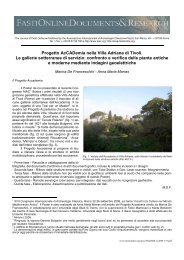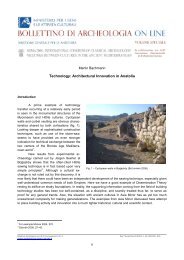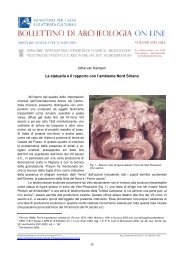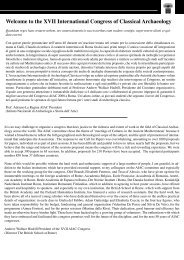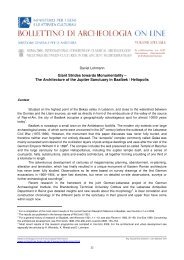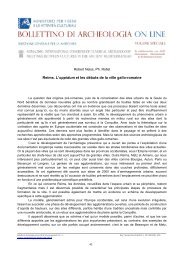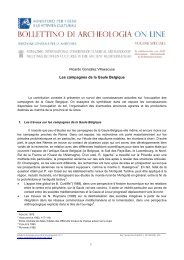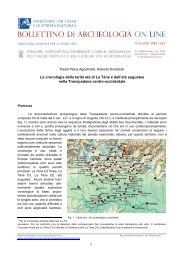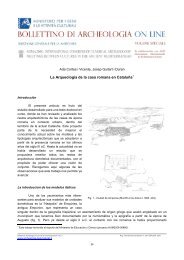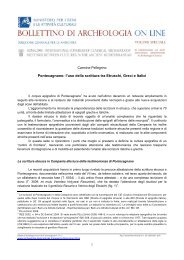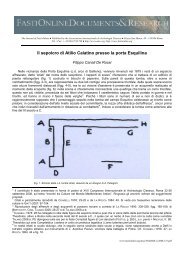XVII Internati<strong>on</strong>al C<strong>on</strong>gress of Classical Archaeology, Roma 22-26 Sept. 2008Sessi<strong>on</strong>: <str<strong>on</strong>g>Roman</str<strong>on</strong>g> and Barbariancremati<strong>on</strong> so the use of any coff<str<strong>on</strong>g>in</str<strong>on</strong>g> at all can be seen as a dem<strong>on</strong>strati<strong>on</strong> of some level of wealth or perceivedstatus 8 .MaterialsThree materials are used for coff<str<strong>on</strong>g>in</str<strong>on</strong>g>s <str<strong>on</strong>g>in</str<strong>on</strong>g> Brita<str<strong>on</strong>g>in</str<strong>on</strong>g>: wood, lead and st<strong>on</strong>e. Unsurpris<str<strong>on</strong>g>in</str<strong>on</strong>g>gly, lead and st<strong>on</strong>eappear to have been the more prestigious but this is not to say that wooden coff<str<strong>on</strong>g>in</str<strong>on</strong>g>s were somehow lowstatus. Of the 453 burials excavated at the Bath Gate cemetery at Cirencester, for example, <strong>on</strong>ly 72 (16%)were c<strong>on</strong>ta<str<strong>on</strong>g>in</str<strong>on</strong>g>ed with<str<strong>on</strong>g>in</str<strong>on</strong>g> wooden coff<str<strong>on</strong>g>in</str<strong>on</strong>g>s; at the same time <strong>on</strong>ly <strong>on</strong>e (0.2%) was c<strong>on</strong>ta<str<strong>on</strong>g>in</str<strong>on</strong>g>ed <str<strong>on</strong>g>in</str<strong>on</strong>g> a lead coff<str<strong>on</strong>g>in</str<strong>on</strong>g>, and<strong>on</strong>ly five (1.1%) <str<strong>on</strong>g>in</str<strong>on</strong>g> st<strong>on</strong>e coff<str<strong>on</strong>g>in</str<strong>on</strong>g>s. At the somewhat wealthier Cemetery 3 at Poundbury, c<strong>on</strong>ta<str<strong>on</strong>g>in</str<strong>on</strong>g><str<strong>on</strong>g>in</str<strong>on</strong>g>g burialsdat<str<strong>on</strong>g>in</str<strong>on</strong>g>g ma<str<strong>on</strong>g>in</str<strong>on</strong>g>ly to the 4 th century AD, 856 (77%) of the 1118 burials excavated prior to 1982 were <str<strong>on</strong>g>in</str<strong>on</strong>g> woodencoff<str<strong>on</strong>g>in</str<strong>on</strong>g>s, <strong>on</strong>ly 75 (7%) <str<strong>on</strong>g>in</str<strong>on</strong>g> lead or st<strong>on</strong>e <strong>on</strong>es 9 . At the Trentholme Drive site <str<strong>on</strong>g>in</str<strong>on</strong>g> York, <strong>on</strong> the other hand, almostall of the 350 burials excavated were c<strong>on</strong>ta<str<strong>on</strong>g>in</str<strong>on</strong>g>ed with<str<strong>on</strong>g>in</str<strong>on</strong>g> coff<str<strong>on</strong>g>in</str<strong>on</strong>g>s but <strong>on</strong>ly two of them were st<strong>on</strong>e 10 .In all of these cases the choice of material appears to have held particular significance. As Toller hasnoted <str<strong>on</strong>g>in</str<strong>on</strong>g> his catalogue of the lead coff<str<strong>on</strong>g>in</str<strong>on</strong>g>s of <str<strong>on</strong>g>Roman</str<strong>on</strong>g> Brita<str<strong>on</strong>g>in</str<strong>on</strong>g> the <str<strong>on</strong>g>di</str<strong>on</strong>g>stributi<strong>on</strong> of these 243 pieces is reflectiveless of the locati<strong>on</strong> of lead resources than it is of the ‘wealth <str<strong>on</strong>g>in</str<strong>on</strong>g> <str<strong>on</strong>g>Roman</str<strong>on</strong>g> Brita<str<strong>on</strong>g>in</str<strong>on</strong>g>’ more generally 11 . In otherwords, people were not simply us<str<strong>on</strong>g>in</str<strong>on</strong>g>g the material that was to hand. The majority of the lead pieces arespread over south-eastern and southern Brita<str<strong>on</strong>g>in</str<strong>on</strong>g>, with 55% com<str<strong>on</strong>g>in</str<strong>on</strong>g>g from cemeteries <str<strong>on</strong>g>di</str<strong>on</strong>g>rectly associated withmajor urban centres, particularly York, Dorchester, Colchester and L<strong>on</strong>d<strong>on</strong> 12 . Even <str<strong>on</strong>g>in</str<strong>on</strong>g> a prov<str<strong>on</strong>g>in</str<strong>on</strong>g>ce wellendowedwith m<str<strong>on</strong>g>in</str<strong>on</strong>g>eral resources, lead can never have been a cheap material <str<strong>on</strong>g>in</str<strong>on</strong>g> which to bury <strong>on</strong>eself. Thesame is no doubt true of st<strong>on</strong>e.The decorated sarcophagi<str<strong>on</strong>g>Roman</str<strong>on</strong>g>o-British sarcophagi, or st<strong>on</strong>e coff<str<strong>on</strong>g>in</str<strong>on</strong>g>s, are relatively comm<strong>on</strong> but, due to the scarcity ofdecorated pieces, have received little scholarly attenti<strong>on</strong> 13 . The same is true of the numerous undecoratedsarcophagi from Gaul and the Rh<str<strong>on</strong>g>in</str<strong>on</strong>g>eland. In part this is because these pla<str<strong>on</strong>g>in</str<strong>on</strong>g>-sided pieces do not fit theresearch agenda of the more art historically m<str<strong>on</strong>g>in</str<strong>on</strong>g>ded scholars who have been resp<strong>on</strong>sible for the publicati<strong>on</strong>of the bulk of sculpted st<strong>on</strong>e objects <str<strong>on</strong>g>in</str<strong>on</strong>g> the north-western prov<str<strong>on</strong>g>in</str<strong>on</strong>g>ces (fig. 1). In her comprehensive study of art<str<strong>on</strong>g>in</str<strong>on</strong>g> Brita<str<strong>on</strong>g>in</str<strong>on</strong>g> under the <str<strong>on</strong>g>Roman</str<strong>on</strong>g>s, for example, Toynbee menti<strong>on</strong>s seven sarcophagi, of which <strong>on</strong>ly five arecarved from local materials 14 . However, sarcophagi have also received little attenti<strong>on</strong> <str<strong>on</strong>g>in</str<strong>on</strong>g> stu<str<strong>on</strong>g>di</str<strong>on</strong>g>es of <str<strong>on</strong>g>Roman</str<strong>on</strong>g>o-British funerary practice; <str<strong>on</strong>g>in</str<strong>on</strong>g> her study of high-status burials between the 1 st and 3 rd centuries, for example,Struck <str<strong>on</strong>g>di</str<strong>on</strong>g>scusses built funerary m<strong>on</strong>uments, grave goods, and the locati<strong>on</strong> of burials, but not sarcophagi 15 .In fact, well over a hundred <str<strong>on</strong>g>Roman</str<strong>on</strong>g>o-British sarcophagi have been identified. These fall <str<strong>on</strong>g>in</str<strong>on</strong>g>to three<str<strong>on</strong>g>di</str<strong>on</strong>g>st<str<strong>on</strong>g>in</str<strong>on</strong>g>ct categories:1. Imports (carved from n<strong>on</strong>-British st<strong>on</strong>e, probably outside of the prov<str<strong>on</strong>g>in</str<strong>on</strong>g>ce).2. Locally-produced decorated or <str<strong>on</strong>g>in</str<strong>on</strong>g>scribed pieces (<str<strong>on</strong>g>in</str<strong>on</strong>g> British st<strong>on</strong>e).3. Locally-produced undecorated pieces (<str<strong>on</strong>g>in</str<strong>on</strong>g> British st<strong>on</strong>e) 16 .…………………………………………8 See PHILPOTT 1991, 53, and QUENSEL-VON-KALBEN 2000, 223.9 See GREEN 1982, 64.10 See VINER, LEECH 1982, 69–88, and WENHAM 1968, 33–39.11 TOLLER 1977.12 TOLLER 1977, 2–3.13 On this po<str<strong>on</strong>g>in</str<strong>on</strong>g>t, see PHILPOTT 1991, 53.14 See TOYNBEE 1964, 210–211; as Walker (1990, 9) has noted, un-decorated sarcophagi are <strong>on</strong>ly fleet<str<strong>on</strong>g>in</str<strong>on</strong>g>gly <str<strong>on</strong>g>di</str<strong>on</strong>g>scussed <str<strong>on</strong>g>in</str<strong>on</strong>g> KOCH,SICHTERMANN 1982, and were not catalogued by Espéran<str<strong>on</strong>g>di</str<strong>on</strong>g>eu.15 STRUCK 2000, 85–92.16 There appear to be no examples of a possible fourth category, locally-produced sarcophagi carved from imported materials, like thenorth-Italian sarcophagi <str<strong>on</strong>g>di</str<strong>on</strong>g>scussed <str<strong>on</strong>g>in</str<strong>on</strong>g> GABELMANN 1973, many of which are carved <str<strong>on</strong>g>in</str<strong>on</strong>g> Proc<strong>on</strong>nesian marble.Bollett<str<strong>on</strong>g>in</str<strong>on</strong>g>o <str<strong>on</strong>g>di</str<strong>on</strong>g> Archeologia <strong>on</strong> l<str<strong>on</strong>g>in</str<strong>on</strong>g>e I 2010/ Volume speciale E / E10 / 2 Reg. Tribunale Roma 05.08.2010 n. 330 ISSN 2039 - 0076www.<str<strong>on</strong>g>archeologia</str<strong>on</strong>g>.beniculturali.it/pages/pubblicazi<strong>on</strong>i.html15
B. Russell – <str<strong>on</strong>g>Sarcophagi</str<strong>on</strong>g> <str<strong>on</strong>g>in</str<strong>on</strong>g> <str<strong>on</strong>g>Roman</str<strong>on</strong>g> Brita<str<strong>on</strong>g>in</str<strong>on</strong>g>Abb. 1 – Undecorated <str<strong>on</strong>g>Roman</str<strong>on</strong>g>o-British sarcophagi <str<strong>on</strong>g>in</str<strong>on</strong>g> the gardens of the Yorkshire Museum.Only three sarcophagi from Brita<str<strong>on</strong>g>in</str<strong>on</strong>g> can be assigned c<strong>on</strong>fidently to the first of these categories. Twoare products of metropolitan workshops while a fragmentary third example, carved from Pentelic marble,must be Attic <str<strong>on</strong>g>in</str<strong>on</strong>g> form 17 . All come from rural sites close to L<strong>on</strong>d<strong>on</strong> and apparently date to the first half of the3 rd century AD. A fourth piece, the marble fragment depict<str<strong>on</strong>g>in</str<strong>on</strong>g>g the Muses found built <str<strong>on</strong>g>in</str<strong>on</strong>g>to the wall of a church<str<strong>on</strong>g>in</str<strong>on</strong>g> Harwich and now <str<strong>on</strong>g>in</str<strong>on</strong>g> the British Museum, is less certa<str<strong>on</strong>g>in</str<strong>on</strong>g>ly an ancient import 18 . The st<strong>on</strong>e used <str<strong>on</strong>g>in</str<strong>on</strong>g> not ofMe<str<strong>on</strong>g>di</str<strong>on</strong>g>terranean orig<str<strong>on</strong>g>in</str<strong>on</strong>g> but could be Pyrenean. S<str<strong>on</strong>g>in</str<strong>on</strong>g>ce Koch and Sichtermann argued that it was a prov<str<strong>on</strong>g>in</str<strong>on</strong>g>cialcopy of a metropolitan type, it might represent an import from Gaul 19 . However, this is pure hypothesis and,as Walker notes, it could just as likely be a later collector’s piece, perhaps reworked <str<strong>on</strong>g>in</str<strong>on</strong>g> the 18 th or 19 thcenturies, and so not an ancient import. S<str<strong>on</strong>g>in</str<strong>on</strong>g>ce all of the imported architectural elements <str<strong>on</strong>g>in</str<strong>on</strong>g> Brita<str<strong>on</strong>g>in</str<strong>on</strong>g> are oflimited <str<strong>on</strong>g>di</str<strong>on</strong>g>mensi<strong>on</strong>s, these sarcophagi are the largest s<str<strong>on</strong>g>in</str<strong>on</strong>g>gle imported st<strong>on</strong>e objects <str<strong>on</strong>g>in</str<strong>on</strong>g> Brita<str<strong>on</strong>g>in</str<strong>on</strong>g> 20 . Though n<strong>on</strong>e17 The two metropolitan pieces, from Clapt<strong>on</strong> (L<strong>on</strong>d<strong>on</strong>) and Englefield Green (Surrey), are <str<strong>on</strong>g>di</str<strong>on</strong>g>scussed by Toynbee (1964, 210–211),while the Attic piece from Welwyn (Hertfordshire) is described <str<strong>on</strong>g>in</str<strong>on</strong>g> Rook, Walker and DENSTON 1984, 149–160; more fragments of theWelwyn sarcophagus are due to be published by M. Henig <str<strong>on</strong>g>in</str<strong>on</strong>g> a forthcom<str<strong>on</strong>g>in</str<strong>on</strong>g>g CSIR volume.18 WALKER 1990, no. 70.19 KOCH, SICHTERMANN 1982, 308.20 Most marble was imported <str<strong>on</strong>g>in</str<strong>on</strong>g>to Brita<str<strong>on</strong>g>in</str<strong>on</strong>g> <str<strong>on</strong>g>in</str<strong>on</strong>g> panel form, for use as wall veneer or floor tiles; statues are found but they are generallysmall <str<strong>on</strong>g>in</str<strong>on</strong>g> size (excepti<strong>on</strong>s be<str<strong>on</strong>g>in</str<strong>on</strong>g>g the busts from the villa at Lull<str<strong>on</strong>g>in</str<strong>on</strong>g>gst<strong>on</strong>e <str<strong>on</strong>g>in</str<strong>on</strong>g> Kent now <str<strong>on</strong>g>in</str<strong>on</strong>g> the British Museum (see TOYNBEE 1964, 59–62);the largest imported architectural elements meanwhile are the small columns and capitals <str<strong>on</strong>g>in</str<strong>on</strong>g> French limest<strong>on</strong>e from the Ner<strong>on</strong>ian andFlavian phases of the palatial-villa at Fishbourne (see BLAGG 1990, 35).Bollett<str<strong>on</strong>g>in</str<strong>on</strong>g>o <str<strong>on</strong>g>di</str<strong>on</strong>g> Archeologia <strong>on</strong> l<str<strong>on</strong>g>in</str<strong>on</strong>g>e I 2010/ Volume speciale E / E10 / 2 Reg. Tribunale Roma 05.08.2010 n. 330 ISSN 2039 - 0076www.<str<strong>on</strong>g>archeologia</str<strong>on</strong>g>.beniculturali.it/pages/pubblicazi<strong>on</strong>i.html16



